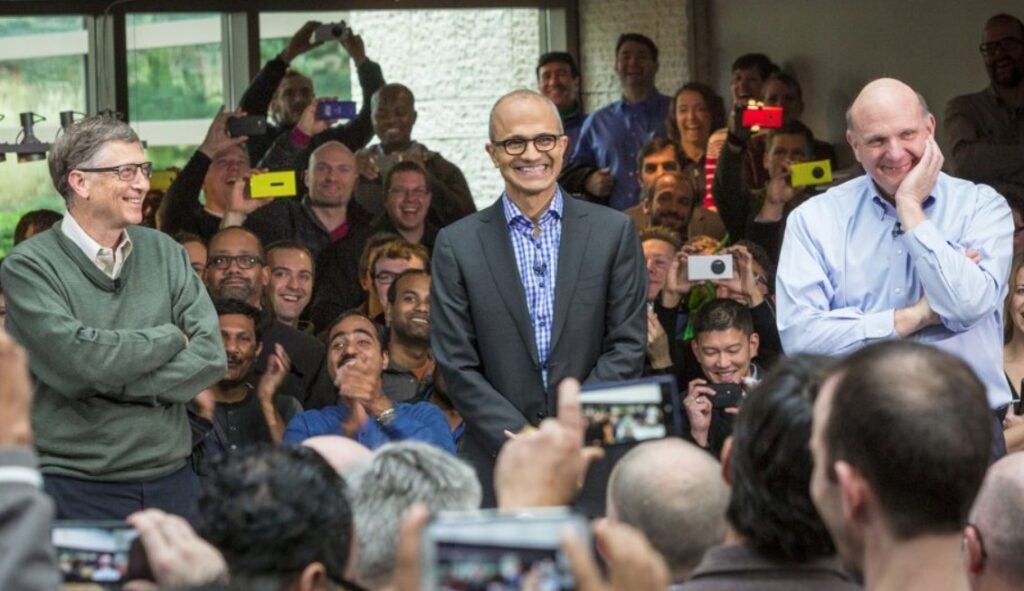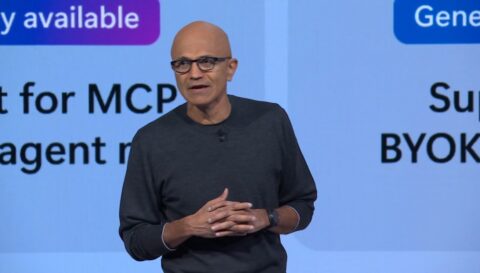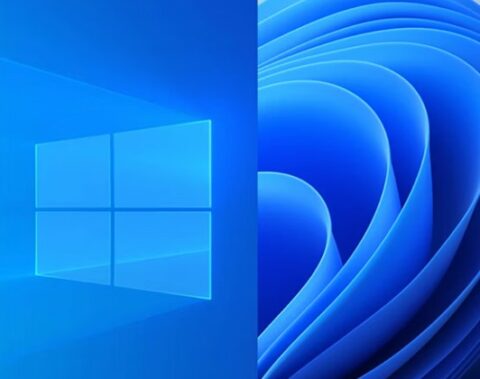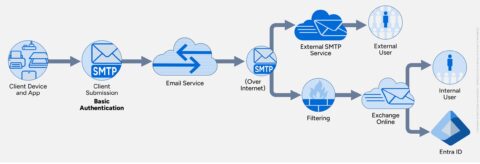Updated: April 4, 2025 (April 4, 2025)
BlogMicrosoft Turns 50: Directions Looks at the Good, Bad, and the Future
Fifty years ago today, April 4, Microsoft got its start. A lot has transpired in that time. Microsoft has launched all kinds of products and services – from Azure to Zune. During that time, its three CEOs have weathered legal battles, executed many good (and not so good) acquisitions, and managed to change with the times better than just about any tech company still in existence.

Directions on Microsoft has been covering Microsoft through all its phases for more than 30 of those years. Some of our analysts previously worked at Microsoft; others worked for Microsoft partners and Microsoft enterprise customers. So who better to take stock of Microsoft on this momentous occasion than the Directions analysts.
Donning my journalist hat, I asked our analysts three questions:
- What product, strategy, or event from Microsoft’s first 50 years do you still consider impressive (for its time or even to this day)
- What’s one (and only one!) product or strategy that you consider/considered ill-advise
- What’s one tip you’d give enterprise customers who will be sticking with Microsoft for at least part of its next 50 years
Their answers may (or may not) surprise you.
The good: SharePoint, the product that has endured. In 25 years, it’s grown, morphed and transformed from server product to cloud behemoth, birthed a global community of evangelists and events, and spawned an eco-system of vendors and products. With the introduction of M365 Copilot, it transformed once again as a gold mine of organizational data for a new generation of productivity apps.
The not-so-good: Windows Phone – When Microsoft introduced the Windows Mobile phone in about 2004, it failed to innovate and may have lacked vision as it rapidly lost share to Apple’s iPhone when launched in 2006 and later, Android. Buying Nokia in 2011 was arguably Microsoft’s last significant effort to retake market share but it may not have been the best option. While not a cure-all, RIM’s Blackberry may have been a better acquisition at the time with its secure email server, corporate clients and younger global consumer base for its Blackberry Messenger (BBM) service.
Your tip: Stay flexible, my friends. Technology is changing faster than ever, and quantum computing is on the horizon. Maintain a flexible IT structure and organization for the adoption of new technologies Microsoft will introduce. Invest in training to keep your workforce engaged and its skills current.
The good: Microsoft has an extraordinary, maybe even unique ability to cross chasms. The technology industry – indeed, all industries – are littered with the dead, decaying corpses of once-high-flying companies that couldn’t adapt: Digital Equipment, Wang, Lotus, Compaq, (maybe even) Intel. Microsoft, unlike any other company I can name, has demonstrated an unparalleled and frankly historic ability to confront, surmount, and thrive through paradigm shifts: GUIs, client-server, internet, cloud, AI. It’s really quite extraordinary.
The not-so-good: Fighting the United States government. Microsoft’s long war with the Department of Justice over anti-trust consumed it for years, depressed the stock price, and hurt its reputation – when resources would have been better devoted to innovation. The good news is that they appear to have learned from it with a proactive CELA team working with, instead of at odds with, governments both in the US and globally.
Your tip: Do what’s right for you. Microsoft positions itself, to the extent it can, as one-stop shopping. Know your requirements, do your homework, comparison-shop, negotiate, and bargain. Microsoft may well have the right products and services for you, but being an informed customer is better for you, your organization, and ultimately for Microsoft.
The good: Microsoft retaining the rights to sell DOS to other companies, besides IBM. Because the original IBM PC (code-named Acorn) was made mostly from off-the-shelf components, everything except the ROM-BIOS was available to and from other manufacturers. By reverse engineering the BIOS, IBM PC clones came to the market from a variety of vendors such as Compaq. This established the PC as a highly-configurable device that could run a wide variety of applications—creating the foundation for Microsoft to truly be a software company.
The not-so-good: Not realizing that the antitrust case would be tried in a court of law, rather than the court of public opinion. In the former realm, Microsoft did not have the smartest people in the room, merely the most arrogant.
Your tip: In the words of Ronald Reagan, trust but verify. Almost anything anyone at Microsoft tells you is accompanied by a significant amount of sales puffery. It is not that the product or service won’t work, but it won’t always work as advertised. The weird thing is, they believe what they are saying, and eventually it may all come to pass.
The good: Microsoft’s move to the enterprise datacenter. If you told me, back in the days of Windows 3.x running on top of DOS, that nearly every Fortune 1000 company would have Microsoft software (let alone Windows!) in their data centers and powering their business, I’d have said you were nuts. But it happened. A lot of the credit goes to Dave Cutler and the early Windows NT team – they built the foundation of the modern Microsoft.
The not-so-good: Its obsession with consumer business. I don’t know why, but even as they make literal billions of dollars selling to businesses, the company has an inferiority complex around consumer business. So they keep trying to do things like Zune, or Xbox, or Bing. The only thing those efforts do is set money on fire and serve as internal distractions.
Your tip: Keep Microsoft honest. The best way to control Microsoft costs has always been to have a credible alternative. Nothing makes the sales team sharpen their pencils more than a plausible plan to move to Linux. So keep them honest, invest in the due diligence needed to have an exit plan, even if you hope not to use it.
The good: In terms of strategy, I’d say that the bundling of the Office suite back in the 1990s remains a masterstroke. Back then, all the business apps were standalone. Companies used WordPerfect, and Lotus 1-2-3, and dBase. What we take for granted as an office suite today was all individual programs. Microsoft’s products weren’t the strongest in their respective categories, but they were good enough in comparison and less expensive as a bundle than buying the individual best of breed programs. In the corporate world, where purchase decisions are usually made by finance rather than the actual users, that made buying Office the go-to choice (it’s good enough and saves us money!) and helped make it the corporate standard it has become.
The not-so-good: Can I call out an entire category? Microsoft as a “consumer technology” company ended in the mid-late 1990s. With the exception of Xbox, Microsoft has had few wins of any measure there – and Xbox might have arguably flopped at launch if they hadn’t bought Bungie (the makers of Halo). So many of their attempts in that area have been utter misses either because they think of the technology first and the customer second, or because they’re more concerned about partners than the actual customers (such as the awful licensing terms for music purchased on Zune).
Your tip: Microsoft’s an amazing technology company, but a lot of their financial success comes from bundling, licensing, and carefully choosing their direct customers – who are often OEMs, resellers, or even corporate procurement officers rather than the actual end-users of their products and services. It’s a strategy that’s worked well for decades and they’re very good at it. Keep that in mind as you continue to use their products in your enterprise; understand who their real customers are, and you’ll have a better handle on how to work with them in the future.
The good: “Island driving”: As a business, Microsoft’s primary strategy over 50 years has been to expand from one monopoly (PC operating systems originally) into a new one with a few basic tactics such as bundling and volume discounting. The monopoly business always gave Microsoft something solid to go back to, lick its wounds, and try again — it never really had to “bet the company”.
The not-so-good: Consumer brand envy. Competitors have been a great source of inspiration for its engineers, but the long rivalries with consumer brands like Apple, Google, Sony, and so on took billions out of investor’s pockets. Pursuing consumer Internet business did teach Microsoft how to run large data centers, however, which positioned it to enter cloud application and infrastructure services. And crashing in mobile and (initially) cloud infrastructure also cleared the way for Satya Nadella to become CEO.
Your tip: Diversify. For every category where Microsoft is a big component of your IT spending, make sure there’s a credible competitor with at least a small foothold in your business. And as Microsoft continues to expand in the cloud, you can be one of those competitors, by retaining staff and vendors who can run at least part of your data center infrastructure.
The good: Windows 95. An amazing product at the right time from an incredibly small team (by comparison to today) that changed the world. Outside of Xbox, the last time anyone stayed up until midnight to buy consumer computing technology from Microsoft at a store.
The not-so-good: Windows Home Server. Sure, it had a small hobbyist market that it could appeal to – but the market for such a product was always extremely small. It was in many ways a product of Microsoft employees for Microsoft employees (or nerds of a feather.)
Your tip: Be prepared to pay more than you want – prices rise and strategies change… you will need to iterate more rapidly on product versions than you ever had to in the past.
The good: I keep coming back to Visual Basic on this one. It opened up GUI programming to a wide audience and influenced the way desktop apps would be designed for decades. It led to VBA, which still lives. And its tools performed surprisingly well on the hardware back in the day thanks to portions of it that were implemented in assembly.
The not-so-good: Someone’s gotta say Microsoft Bob here, so Bob. Although, if generative AI were available back then…
Your tip: There will always be a lot of noise coming out of Microsoft, but within that there is always a strong signal. Enjoy the noise, but stay alert, and keep fiddling with the tuning knob (using Directions, for example) to clear away the fuzz.
The good: It’s got to be SQL Server. A beautiful product from the beginning to now. Met the needs for easy query and robust performance and security that others are still trying to emulate.
The not-so-good: Windows ME. Two concerns: 1. Never let the interns influence product design. 2. You don’t always need to rewrite things.
Your tip: Watch the pendulum swing. There’s a resurgence of moving back on-prem for a reason. Many are finding it too expensive to be in the cloud. But realize (tip 2) that on-prem will come with subscriptions now. You’re on the annuity train.
Having covered Microsoft for more than 40 years myself, I can’t resist weighing in, too:
The good: I COULD say Notepad here and call it a day. But I’d also be remiss not to mention Microsoft’s development and launch of Azure. This was an impressive feat for a company with very little cloud experience to come together and pull this off fairly quickly and, largely, in secret.
The not-so-good: Microsoft’s decision to go ahead and launch Windows 8 after all the negative feedback from enterprises who knew a touch-first experience would not work for businesses. I’m still befuddled that this happened, but glad Windows 8.1 and then, 10 didn’t take all that long to come to the rescue.
Your tip: Remember that Microsoft’s ultimate goal is to make you dependent on its cloud and to upsell you to its priciest subscriptions (no matter what they say publicly about customer choice). Plan and negotiate with that in mind.















